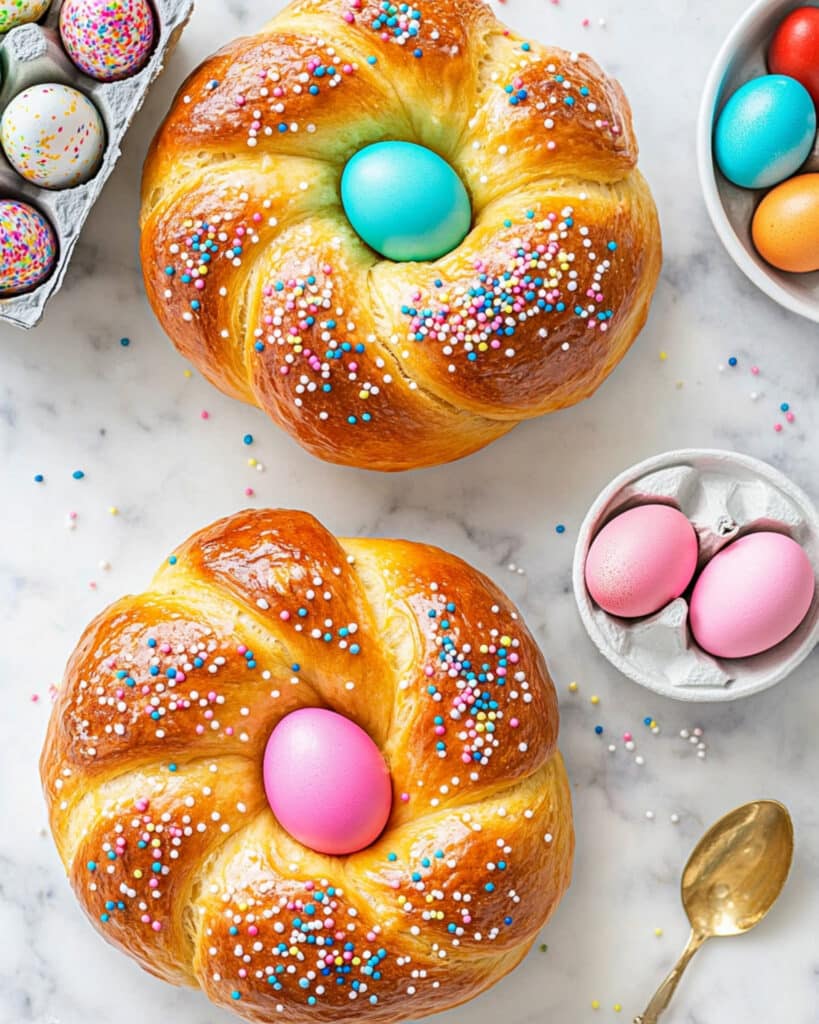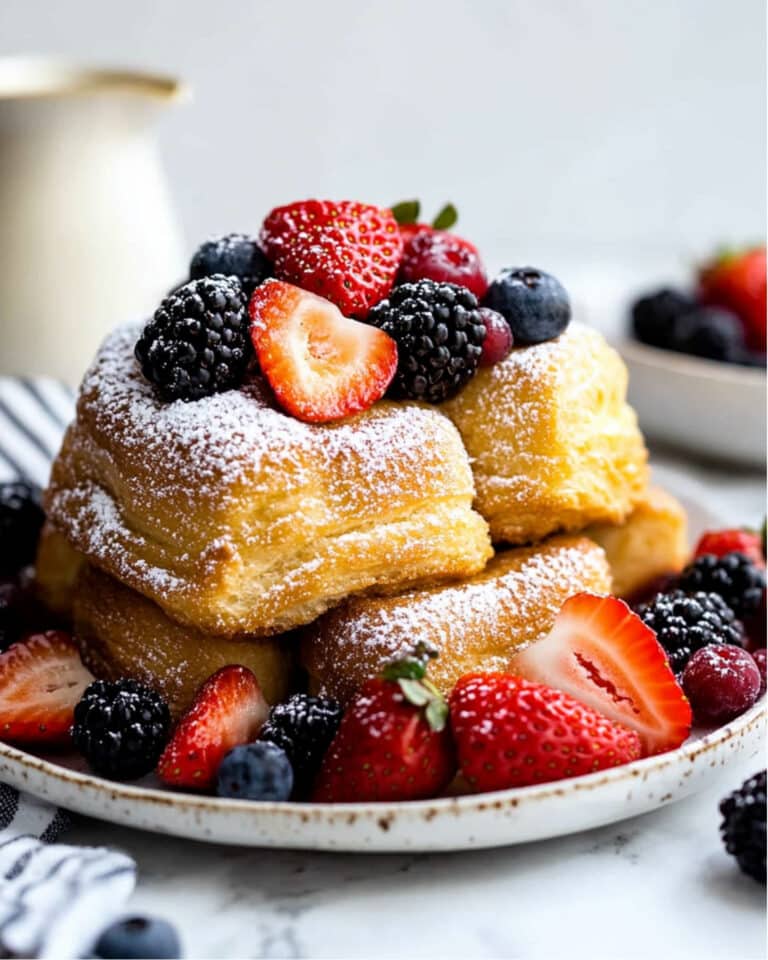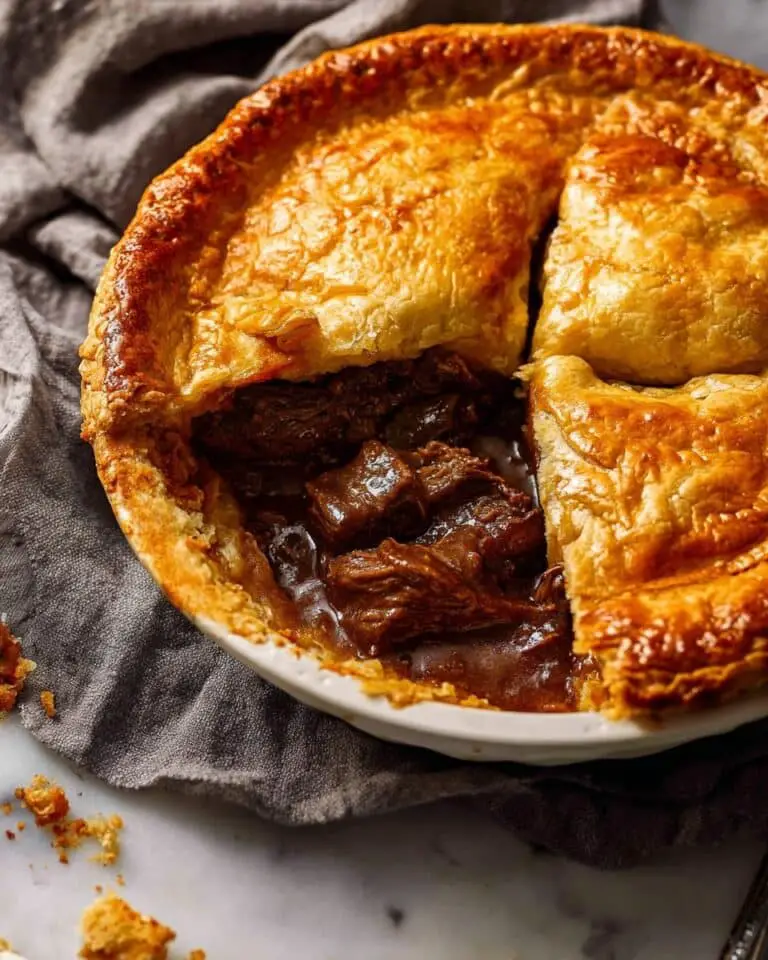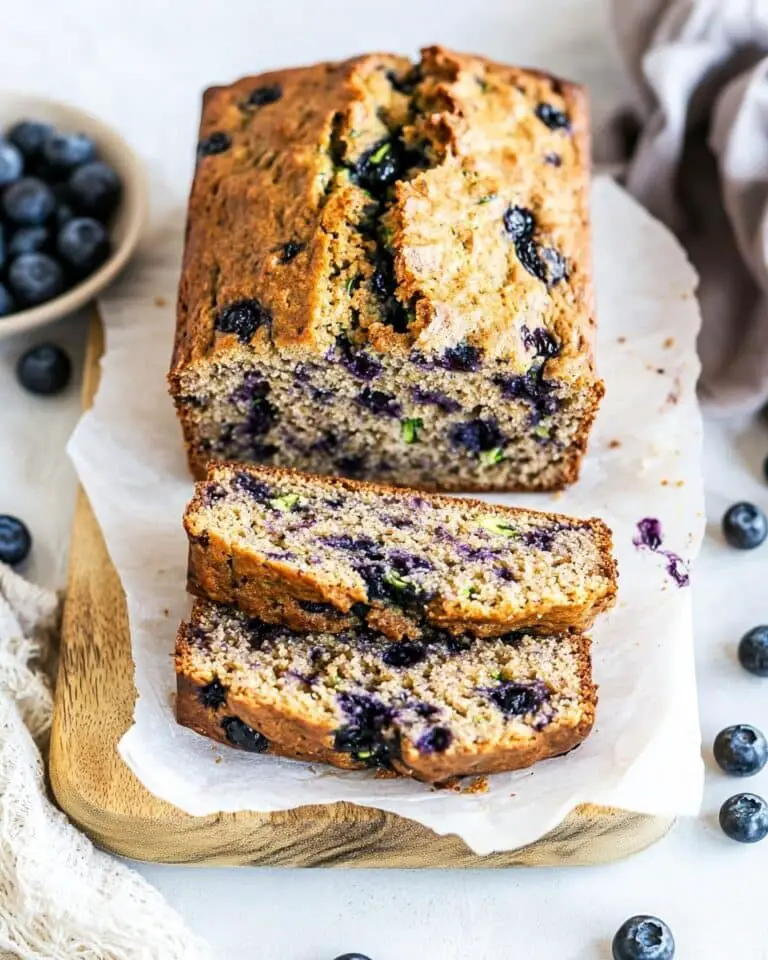This traditional Italian Easter Bread is a feast for both the eyes and taste buds. With its soft, slightly sweet texture and colorful decorations, it brings festive charm to any Easter table. The braided wreath design, adorned with dyed eggs and sprinkles, makes this bread as beautiful as it is delicious—a perfect centerpiece for your holiday celebrations that everyone will love.
Why You’ll Love This Recipe
- Stunning Presentation: The braided wreath design with colorful eggs creates a beautiful centerpiece that will impress your guests.
- Perfectly Sweet: This bread has just the right balance of sweetness—not too much like a dessert, but enough to complement your Easter feast.
- Family Tradition: Making this bread can become a cherished annual tradition, especially with kids who’ll love decorating with the colored eggs and sprinkles.
- Versatile: Enjoy it for breakfast with coffee, as part of your Easter brunch, or as a special treat alongside your holiday dinner.
Ingredients You’ll Need
- Milk: Creates a tender, soft texture in the bread and activates the yeast.
- Butter: Adds richness and flavor to the dough—unsalted allows you to control the salt level.
- Instant Yeast: The magic ingredient that makes our bread rise beautifully—rapid rise variety speeds up the process.
- Salt: Just a touch enhances all the flavors without making the bread salty.
- Sugar: Provides sweetness and helps feed the yeast for a good rise.
- Eggs: Give structure to the bread while adding richness to the dough. You’ll need separate eggs for the dough and for the egg wash.
- Flour: Forms the structure of the bread—all-purpose works perfectly here.
- Dyed Easter Eggs: The crowning glory! These colorful eggs transform the bread into a true Easter celebration.
- Sprinkles: Add a festive touch and extra sweetness—choose pastel colors for Easter.
Note: You’ll find the complete list of ingredients, along with their exact measurements, in the printable recipe card at the bottom of this post.
Variations
Want to make this Easter bread your own? Here are some delicious ideas:
- Citrus Zest: Add lemon or orange zest to the dough for a bright, aromatic flavor.
- Anise or Vanilla: Incorporate a teaspoon of anise extract for a traditional Italian flavor, or vanilla for a sweeter profile.
- Mini Version: Make six smaller wreaths instead of three larger ones—perfect for individual servings.
- Icing Drizzle: After baking and cooling, drizzle with a simple powdered sugar glaze for extra sweetness.
- Dried Fruit: Knead in some golden raisins or dried cranberries for little bursts of flavor and texture.
How to Make Italian Easter Bread
Step 1: Prepare the Milk and Butter
In a small saucepan, warm the milk and butter over medium-low heat until it reaches 120-130°F. This temperature activates the yeast without killing it. Stir occasionally until the butter melts completely.
Step 2: Make the Yeast Mixture
In a large mixing bowl, combine the yeast, salt, and sugar. Whisk in the two eggs until well incorporated. Pour in the warm milk and butter mixture, then add two cups of flour.
Step 3: Mix the Dough
Using a stand mixer fitted with a dough hook, mix on medium speed for about 2 minutes until smooth. Scrape down the sides of the bowl as needed to incorporate all the flour.
Step 4: Add Remaining Flour
Gradually add the remaining two cups of flour while mixing on medium-low speed. Continue mixing for about 12 minutes until the dough becomes stiff and slightly sticky.
Step 5: Knead the Dough
Transfer the dough to a lightly floured surface and knead by hand for 3-4 minutes. Add only enough flour to prevent sticking—no more than ¼ cup. The dough should feel smooth and elastic.
Step 6: Rest the Dough
Shape the dough into a neat ball, cover it with a clean kitchen towel, and let it rest for 10 minutes. This short rest allows the gluten to relax before shaping.
Step 7: Shape the Bread
Divide the dough into 6 equal pieces using a kitchen scraper. Roll each piece into a 14-inch long rope, about 1 inch thick. Twist two ropes together to create a braid, then form into a circle, pinching the ends firmly together. Place on a parchment-lined baking sheet. Repeat with remaining dough to make three wreaths total.
Step 8: Let the Dough Rise
Cover the shaped wreaths loosely with plastic wrap or a kitchen towel and place in a warm area. Let them rise until doubled in size, about 45-60 minutes.
Step 9: Bake the Bread
Preheat your oven to 350°F. Brush each wreath with egg wash (1 egg whisked with 1 teaspoon water). Sprinkle with colored sprinkles if desired, then gently place a dyed egg in the center of each wreath. Bake one tray at a time for 15-18 minutes, until golden brown.
Step 10: Cool
Transfer the baked bread immediately to a cooling rack. Allow to cool before serving.
Pro Tips for Making the Recipe
- Watch Your Temperature: Keep the milk between 120-130°F—too hot and it will kill the yeast, too cool and the yeast won’t activate properly.
- Kneading Technique: The dough should be kneaded until it passes the “windowpane test”—a small piece should stretch thin enough to see light through without tearing.
- Rising Environment: Create a warm environment for rising by placing the dough in an oven with just the light on, or on top of a preheating oven.
- Egg Placement: Don’t press the dyed eggs too deeply into the dough—they’ll naturally settle into place during baking.
- Separate Baking Sheets: Bake only two wreaths per sheet to ensure even browning and proper air circulation.
How to Serve

Italian Easter Bread makes a wonderful addition to your holiday table in several ways:
Breakfast or Brunch
Serve slices with butter or jam alongside coffee or tea for a festive morning treat.
Easter Meal
Include as part of your Easter dinner table—the bread makes a beautiful centerpiece.
Accompaniments
Pairs wonderfully with:
- Fresh spring fruits like strawberries or citrus
- Italian cheeses like ricotta or mascarpone
- A glass of prosecco for adults
Make Ahead and Storage
Storing Leftovers
Store the bread in an airtight container at room temperature for up to 5 days. If you’ve included the decorated egg, remove it first and store separately in the refrigerator.
Freezing
This bread freezes beautifully for up to 2 months. Wrap tightly in plastic wrap, then aluminum foil. Thaw at room temperature before serving.
Reheating
Warm individual slices in a 300°F oven for about 5 minutes or toast lightly for the best texture.
Make-Ahead Options
You can prepare the dough a day ahead—shape it, cover tightly, and refrigerate without letting it rise. The next day, bring to room temperature (about 1-2 hours) before allowing it to rise and then bake as directed.
FAQs
Can I use active dry yeast instead of instant yeast?
Yes, you can use active dry yeast, but you’ll need to proof it first. Dissolve the yeast in the warm milk with a teaspoon of the sugar and let it sit for 5-10 minutes until foamy before proceeding with the recipe. Your rising time may also be slightly longer.
Are the eggs in the bread safe to eat?
If using raw eggs for decoration, they will become soft-boiled during baking. For food safety, either consume the eggs within 2 hours of baking or use pre-boiled eggs for decoration if you plan to eat them later. Alternatively, you can use plastic decorative eggs if you don’t plan to eat them.
Can I make this bread without a stand mixer?
Absolutely! You can mix the dough by hand using a wooden spoon, then knead on a floured surface for about 10-12 minutes until smooth and elastic. It’s a bit more work, but many Italian grandmothers made this bread by hand for generations!
Why is my bread not as yellow as traditional Italian Easter bread?
Some traditional recipes include saffron for a yellow color. If you’d like a more golden dough, you can add a pinch of saffron to the warm milk mixture or use egg yolks instead of whole eggs in the dough.
Italian Easter Bread brings warmth, tradition, and celebration to your holiday table. With its beautiful braided design and colorful accents, it’s sure to become a treasured part of your Easter festivities. Don’t be intimidated by the braiding process—it’s actually quite simple and forgiving. The real joy of this recipe is in the making, especially when shared with family. Whether you’re continuing an old family tradition or starting a new one, this bread connects us to generations of bakers who have celebrated spring with this special treat. Give it a try this Easter—I promise the smiles around your table will be worth every minute spent creating these beautiful breads!
Print
Italian Easter Bread Recipe
- Prep Time: 2 hours 20 minutes
- Cook Time: 35 minutes
- Total Time: 2 hours 55 minutes
- Yield: 18 servings 1x
- Category: Desserts
- Method: Baking
- Cuisine: Italian
Description
This festive Italian Easter Bread is a beautiful braided sweet bread adorned with colorful dyed eggs and sprinkles. With its soft texture and subtle sweetness, this traditional holiday bread makes a stunning centerpiece for your Easter celebration while delighting everyone with its delicious flavor.
Ingredients
- 1 1/4 cups (300 ml) milk
- 1/3 cup (74 g) unsalted butter, cut into small cubes
- 2 1/4 teaspoons (7 g) rapid rise instant yeast (1 package)
- 1/8 teaspoon kosher salt
- 1/2 cup (100 g) granulated sugar
- 2 large eggs, whisked
- 4 cups (568 g) all-purpose flour, divided, plus more for kneading
- 1 large egg, whisked with 1 teaspoon of water (for egg wash)
- 3 large dyed easter eggs, raw or hard-boiled
- Colored sprinkles
Instructions
- Warm the Milk and Butter – In a small saucepan, add milk and butter. Heat over medium-low heat until it reaches 120 to 130°F (49 to 54ºC), stirring until the butter melts. Do not allow the milk to go above 130°F (54ºC).
- Make the Yeast Mixture – In a large mixing bowl, combine yeast, salt, and sugar. Add 2 eggs and whisk together. Add the warmed milk and butter mixture. Add 2 cups of flour.
- Mix the Dough – Attach a dough hook to a stand mixer and combine on medium speed until smooth, about 2 minutes. Scrape the sides with a spatula as needed to incorporate the flour.
- Add More Flour – Slowly add the remaining 2 cups of flour to the mixer on medium-low speed and scrape the sides as needed. Knead until the dough is stiff and slightly sticky, about 12 minutes.
- Knead the Dough by Hand – Place the dough on a lightly floured board and hand knead for about 3 to 4 minutes, adding more flour to prevent sticking. Do not use more than ¼ cup of flour.
- Rest the Dough – Shape dough into a ball, cover with a dish towel, and allow to rest for 10 minutes.
- Roll the Dough – Use a kitchen scrapper to divide the dough into 6 pieces. Roll each piece to form a 1-inch wide rope, about 14 inches long.
- Shape the Dough – Twist two dough ropes together to create a braided effect, then pinch the ends firmly to secure them. Form the twisted dough into a circle, ensuring the ends are tightly joined. Place it on a large parchment-lined baking sheet. Repeat with the remaining dough ropes. Arrange only two loaves per baking sheet to allow enough space for rising.
- Let the Dough Rise – Loosely cover the shaped dough with plastic wrap or a dish towel and place it in a warm area, such as a proofing box. Let it rise until doubled in size, about 45 to 60 minutes.
- Heat the Oven – Set the rack in the middle position. Heat the oven to 350°F (177ºC).
- Brush with Egg Wash – Whisk together 1 egg and 1 teaspoon of water. Brush each braided bread with the egg wash. If desired, top the bread with sprinkles. Gently place one dyed egg in the center of each braided ring. Do not press into the dough; it will sink as it bakes.
- Bake – Bake one tray at a time until golden brown, approximately 15 to 18 minutes. Quickly transfer the baked bread to a cooling rack to cool.
Notes
- If you’re using raw eggs for decoration, they will be soft-boiled after baking. For food safety, consume the egg within 2 hours of baking.
- To make ahead, you can shape the dough, cover it, and refrigerate without letting it rise. The next day, bring to room temperature and then let rise until doubled.
- For smaller portions, divide the dough to make six smaller loaves instead of three.
- To ensure freshness, if the bread has an egg on top, remove and store it separately. The bread can be stored in an airtight container at room temperature for up to 5 days.
- This recipe is deeply rooted in Italian Easter traditions, where the braided wreath symbolizes the crown of thorns, and the eggs represent new life and resurrection.
- For a flavor variation, you can add 1 teaspoon of anise extract or 1 tablespoon of orange zest to the dough.
Nutrition
- Serving Size: 1 slice
- Calories: 168kcal
- Sugar: 6g
- Sodium: 35mg
- Fat: 5g
- Saturated Fat: 3g
- Unsaturated Fat: 2g
- Trans Fat: 0g
- Carbohydrates: 25g
- Fiber: 1g
- Protein: 4g
- Cholesterol: 38mg









